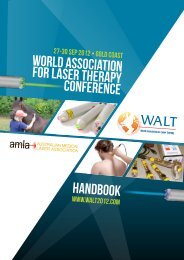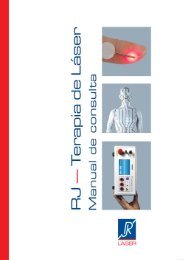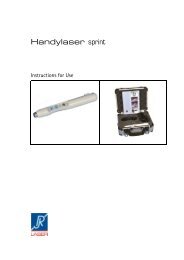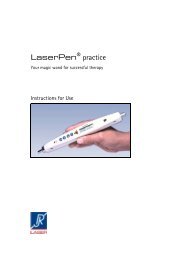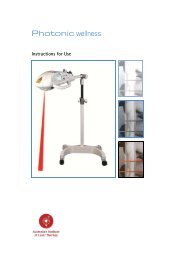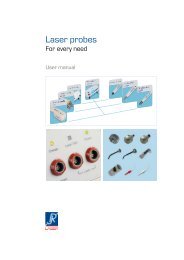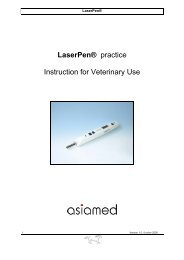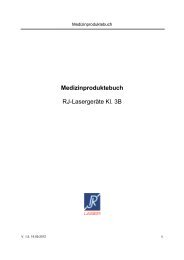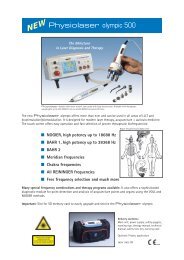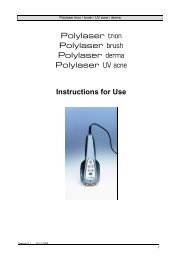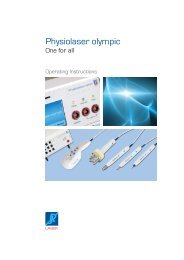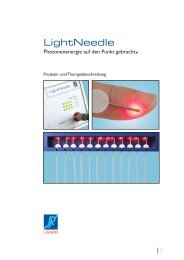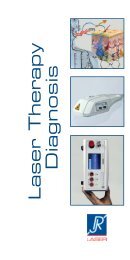LightNeedle - RJ Laser
LightNeedle - RJ Laser
LightNeedle - RJ Laser
Create successful ePaper yourself
Turn your PDF publications into a flip-book with our unique Google optimized e-Paper software.
LASER-NEEDLE THERAPY IN SONK 303<br />
The treatment parameters were deduced from our experimental<br />
data on human osteoblast cultures, which demonstrated<br />
a significant increase in osteoanabolic activity. 17 The<br />
treatment duration and frequency of sessions were chosen<br />
and adapted according to the patient’s functional status and<br />
level of pain.<br />
No additional treatment was administered during the<br />
LLLT therapy period. The patient quit jogging and kept fit<br />
only by weight training once a week, daily exercising on a<br />
cycling ergometer for 30 min, and playing golf occasionally.<br />
We agreed with our patient to assess therapeutic progress<br />
regularly with MRI. The first check-up on April 25, 2005, revealed<br />
distinct regression of the spongiosa edema at the medial<br />
femur condyle, as well as a decrease in size of the subcortical<br />
focus (Fig. 2). The cartilage lesion grade II at the<br />
medial inner femur condyle did not at that point show any<br />
change. The signal intensity of the linearly demarcated subcortical<br />
focus lay under that of the joint cavity, implying no<br />
communication between the lesion and the joint cavity. The<br />
check-up revealed as secondary findings small synovial cysts<br />
in Hoffa’s fat pad. Clinically marked pain reduction and virtually<br />
complete resolution of the patient’s complaints had<br />
also taken place. The patient experienced pain only when<br />
briskly walking. Since he was satisfied with therapy results<br />
up to that point, we agreed to continue it.<br />
The next check-up on June 16, 2005, 3 mo after treatment<br />
onset, revealed nearly complete restitution of the spongiosa<br />
edema (Fig. 3). A faintly visible subcortical demarcation continued<br />
to show on the images. The depth of the cartilage ulceration<br />
at the femoral condyle had receded to less than 50%<br />
of the total cartilage thickness, in accordance with grade II<br />
A<br />
chondropathy. Our patient was clinically entirely pain-free,<br />
even when training vigorously on the bicycle.<br />
During the follow-up period, the patient also did not take<br />
any medication. The final check-up on December 5, 2005,<br />
confirmed the findings of June 16: full recovery had taken<br />
place (Fig. 4). The initially diagnosed Morbus Ahlbäck could<br />
no longer be seen, and 35 wk after treatment onset the chondropathy<br />
at the medial femur condyle showed complete<br />
restitution. Any remaining pathology was at this point minor,<br />
in accordance with grade I chondropathy. The cartilage<br />
at the femoral condyle also showed marked improvement.<br />
There were slight alterations seen in the chondral surface,<br />
consisting only of a solitary, flat lesion, in accordance with<br />
grade I–II chondropathy.<br />
Discussion<br />
MRI has proven to be the most sensitive method to detect<br />
SONK at an early stage, 18 to enhance visualization of bone<br />
marrow, and to distinguish necrotic tissue from viable tissue<br />
with a high level of specificity. 2 This method is currently<br />
considered the gold standard and was therefore used for diagnosis<br />
and therapeutic evaluation in the present case.<br />
Based on MRI findings, SONK can be categorized into four<br />
stages. 19 In stage I, bone marrow edema is present in the<br />
load-bearing zone of the femoral condyle. This initial stage<br />
is reversible. In stage II, early subchondral fracturing with<br />
flattening of the affected weight-bearing portion of the<br />
femoral condyle is observed. Further progression leads to osteochondral<br />
fracturing in stage III, and consequently to secondary<br />
osteoarthritis in stage IV.<br />
FIG. 2. These MRI images, made on April 25, 2005, are a coronary fat-suppressed PD TSE sequence. (A) Axial and (B)<br />
frontal images, demonstrating distinct regression of the spongiosa edema at the medial femur, as well as a decrease in size<br />
of the subcortical focus.<br />
B



